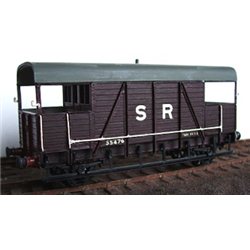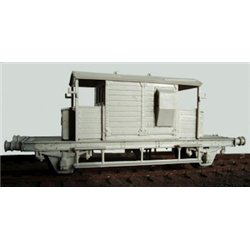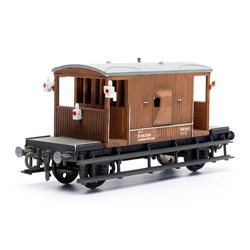Using several shades will add more realism to your layout and create depth. This is how trees are in real life: when...
No products
Product successfully added to your shopping cart
There are 0 items in your cart. There is 1 item in your cart.
Search Tips
Christmas and New Year
We are dispatching orders every weekday apart from Christmas Day, Boxing Day and New Year's Day.
If you select next day delivery at checkout, please note deliveries are not made on public holidays or Sundays.
The shop in Sandown is open 23rd and 24th December, then closed from 25th December, reopening on 30th December.
Were brake vans always positioned at the rear of a rake?
Brake vans, also known as guards' vans or brake coaches, were typically positioned at the rear of a rake of wagons or carriages. However, it's important to note that the positioning of brake vans within a train could vary depending on the specific railway company, the type of train and the operational requirements.
The primary purpose of brake vans is to apply brakes to trains lacking continuous braking systems. They serve to maintain taut couplings and prevent wagon bunching when the locomotive brakes are engaged. These vans are typically positioned at the rear of the train, except when multiple brake vans are employed, as was common in early UK passenger trains before the mandatory implementation of continuous brakes.
The secondarypurpose of a brake van was to provide accommodation for a guard or a train conductor who was responsible for managing the train's safety, particularly during braking and shunting operations. The Brake Van served as a control and observation point, allowing the guard to communicate with the locomotive crew and monitor the entire train.
By placing the brake van at the rear of the train, the guard had a clear view of the wagons or carriages ahead, ensuring the safe and controlled movement of the train. The guard could also apply the brakes on the brake van itself, which would then transmit the braking force to the entire train through a system of vacuum or air pipes.
That being said, there were exceptions to the standard practice of positioning the brake van at the rear. In certain circumstances, particularly on shorter trains or where operational requirements dictated, the brake van might be positioned closer to the front of the train. This allowed the guard to have better visibility and communication with the locomotive crew, especially in situations where shunting or splitting the train was necessary.
An additional factor influencing the placement of brake/guards vans at the end of trains is the longstanding policy on British railways to position brake vehicles, brake ends, or other non-passenger units at both ends of a string of passenger coaches as a precaution against collisions. This practice was maintained for many years, with the Southern Railway/Region continuing this approach for its 4-car EMUs until the mid-sixties. Unlike goods wagons, passenger coaches lack individual handbrakes, making a brake vehicle indispensable for keeping them stationary; otherwise, alternative measures like scotching or spragging are necessary.
When modelling trains with brake vans, it is common practice to position them at the rear of the train for a more prototypical appearance. However, depending on the specific scenario being modelled or personal preferences, enthusiasts may choose to experiment with alternative positions for the brake van to add variety and realism to their model railway operations.
Click here to receive the tips weekly in your mailbox. You can unsubscribe at any time.









